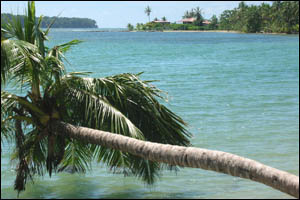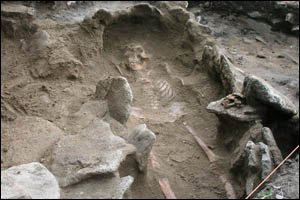|
Isla Colon is a Caribbean island just off
the northwest coast of Panama. Until colonization by Europeans it was
home to small communities of fishermen and farmers maintaining trade
networks that
extended far into the mainland:
|
|
The traces of these communities consist mostly of household
refuse without architectural remains. Excavations
at Sitio Drago, near the
western tip of Isla Colon, produced one of the most complete and
best preserved burials in the region:
|
|
|
|
|

|
|

|
|
|
|
|
|
|
|
|
Objective of visit:
|
|
To survey the current
situation of the site, including the excavation trenches, the new
asphalt road to Bocas del Toro as well as the ever changing coastline
(due to geological movements).
|
|
Date of visit:
|
|
July-August 2006
|
|
Fellow visitors:
|
|
Faculty and students of
the Institute for Tropical
Ecology and Conservation at Boca del
Drago (offering courses in tropical ecology, ethnobotany, herpetology,
primatology and archaeology). The excavations at
Sitio Drago are
directed by Dr.
Tom Wake (Cotsen Institute of Archaeology, UCLA). |
| Results: |
|
A low resolution map,
based on data collected with a handheld GPS-receiver, of the wider
environs of the site and a high resolution contour map of Sitio Drago
showing the present lay-out of the site. |
| Approximate
position and
date of the site: |
|
Isla Colon is an island
in the Bocas del Toro Archipelago, off the Atlantic coast of
northwestern Panama. The island is named after Columbus who sailed
between the island and the mainland in 1502, during his fourth trip to
the New World. Archaeologically the province Bocas del Toro is part of
the Greater Chiriqui area. Precious little research has been performed
in this region that is currently being developed for tourism (replacing
banana, pineapple and teak plantations). Based
on the recovered artifacts (including San
Lorenzo and Bocas type ceramics), and a series
of
radiocarbon samples, Sitio Drago has been dated to ca. 800-1200 CE.
|
| Short description
of the
site: |
|
Sitio Drago is just east
of the small modern settlement at Boca del Drago, consisting mostly of
second and retirement homes. The site comprises about a dozen low
mounds of ancient household refuse on the small strip of dry land
between a swamp forest and the coast. The site is cut by a modern
asphalt road and has possibly partly subsided below the current level
of the Atlantic Ocean. Finds include ceramic vessels with
decorated legs (made to also serve as rattles) as well as beads and
other ornaments made of shell. Further inland, about 3.5 km. east of
Sitio Drago, is Sitio Teca, dated to the Aguas Buenes culture (ca. 0-400 CE).
|
| Additional remarks: |
|
My work in Panama would
not have been
possible without the Cotsen
Institute of Archaeology. |

|
|
|
| HOME |
|
|

